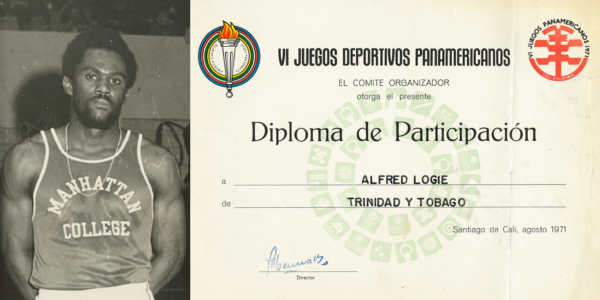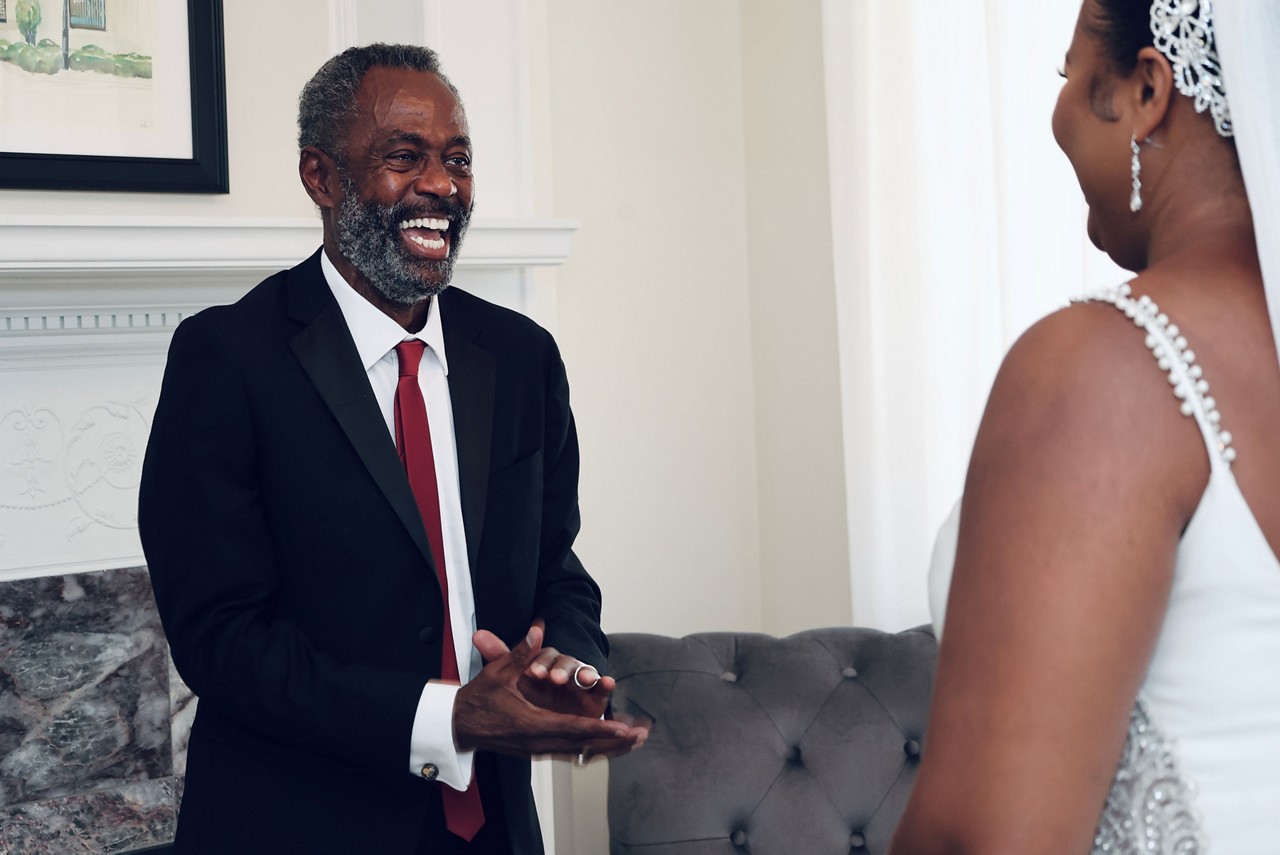
Early Life
Al’s journey from ultra-athlete to transplant advocate can be traced back to his roots. Born in Trinidad in 1949, Al immigrated to the United States at the age of 16 to live with his father to further his education and athletic pursuits. A decorated athlete, he lives his life by the notion, “Be strong and courageous.”
 Al was a star runner for the Manhattan College track team and participated in the Pan American Games.
Al was a star runner for the Manhattan College track team and participated in the Pan American Games.
In 1971, Al represented Trinidad and Tobago in the 400-meter dash at the Pan American Games. With early childhood aspirations to represent his home country in the Olympics, Al’s dream was turning into a reality before his very eyes as he and a fellow teammate made qualifiers for the Olympics in 1972. Though, in the midst of a post-dash celebratory hug among teammates, a collision resulted in an accidental cleat to the back of Al’s heel, an injury requiring 15 stitches.
In an instant, he was forced to change course and pivot—a lifelong dream he was pursuing no longer in the realm of possibility. Despite being deemed ineligible for the Olympics, Al’s need for speed and determination for greatness never wavered. During the same year, he enlisted in the U.S. Army at the age of 23.
Following two years of service, Al settled down in Washington D.C., where he would reside for the majority of his life, building a family, giving back to the community and of course, staying active. In 2003, he participated in what’s known as “the ultimate human race”—the Comrades Marathon—an approximate 54-mile ultramarathon across the Valley of a Thousand Hills in South Africa.
The integrity Al exhibited on the track and in life was never lost on his family, either. Freddy, Al’s eldest son, has forever held a larger-than-life view of his father, recounting always seeing him as “ten feet tall” growing up.
“We're kind of behind the eight ball, you know, being African Americans, [and] Black men in general, so he always pushed us to never settle for mediocrity, never just be okay with the status quo. He was tough, but always, always fair. And then, as I grew up, as we all got older… he just became more and more of a really good friend of mine,” says Freddy.
Sickness
Al always prioritized healthy eating, with a strict vegetarian diet and a highly regimented exercise schedule; so the cause of the unexpected illness he experienced in 2017 was a complex mystery to nearly every medical professional. Over the course of the next several months, he rapidly gained more than fifty pounds and visited a total of six medical specialists, becoming increasingly desperate for an accurate diagnosis with each passing visit.
Originally considered to be a byproduct of a thyroid condition, Al was placed on several medications, but nothing seemed to help. Pam, Al’s wife and fiercest advocate, researched medical options tirelessly, but it wasn’t until a fellow Bible study group member recommended the pair visit the Mayo Clinic in Rochester, Minnesota that things began to take a turn for the better.
While there were no available openings within the near future, Pam took it upon herself to contact the hospital three or more times each and every day. Pam credits her ten years as a police captain as the source of her determination and resilience.
Her consistency paid off as a last-minute appointment eventually became available. The two boarded a plane from Washington D.C. to Minnesota as quickly as possible, where it was ultimately determined that he was suffering from a genetic disease that was causing his liver to produce mutated proteins that were damaging his heart.
He was officially diagnosed with cardiac amyloidosis on March 7, 2017, and later placed on the transplant waiting list for both a heart and liver. Shortly thereafter, Al was checked into the Cardiac Amyloidosis Clinic at Mayo and had 30 pounds of fluid drained from his body. A once thriving, world-class athlete now was temporarily immobile and confined to a wheelchair.
Following his diagnosis, Al was in the hospital for nearly five months, waiting for the heart and liver transplants he so desperately needed. Nevertheless, he continued working remotely as a Civil Engineer with the Federal Highway Administration.
“It was so funny, because he would be on a Zoom meeting, and the doctors would come in, and he'd hold his hand up, you know…and they'd have to come back. After a while, they would just barge in and start talking, and he would be like ‘I'm working [here]…’” says Pam.
Once able, he took to riding a stationary bike every day to keep his mind and body active. Around this same time, Al also joined the Mayo Clinic Support Group for transplant recipients, donors, caregivers, and family members—a community he still meets with weekly, now happily tuning in virtually to provide support for other transplant patients and families now going through the process.
Transplantation
On the afternoon of July 31, 2018, Al received the life-changing call that there was a match for both his heart and liver.
“My faith was strong that I was going to get through this, and it was a call I was awaiting—but when it came… I was in awe. I was very much humbled, yet conflicted,” said Al.
Just six hours later, he was in the operating room receiving the transplanted organs from an anonymous 28-year-old donor. The operation consisted of the heart transplant first, which took nearly 14 hours, and the liver afterward, which took around five hours. After surgery, he was placed in a medically induced coma for five days.
During his hospital stay, he met someone who Al credits for helping him push through the setbacks and obstacles to recovery—Nurse Lacey Ferguson.
“You're in the hospital—this is one of probably the worst times of your life, if not the worst. And I just like to try to make it fun for people and try to make them not necessarily feel like a patient, because I wouldn't want to feel like a patient if I was in their shoes,” says Lacey.
 Nurse Lacey’s cookie tribute to the nickname Al bestowed upon her during his transplant recovery.
Nurse Lacey’s cookie tribute to the nickname Al bestowed upon her during his transplant recovery.
Al’s younger son, Denis, finds solace in the once-in-a-lifetime lessons that he has now been fortunate to realize. “Some of the greatest takeaways I have learned from this experience is to cherish any and all moments we have with our loved ones. Life can be so unpredictable at times; your efforts should be focused on spending and enjoying as much quality time with your family as possible,” says Denis. “This experience has also facilitated some introspection and changed my perspective on life as a whole. Letting the trivial, meaningless things go on the day-to-day and focus on the parts of life which have true value and significance,” he adds.
 Al's 72nd birthday ride
Al's 72nd birthday ride
 Al Logie with fellow transplant recipient and support group member, Mark Hunziker
Al Logie with fellow transplant recipient and support group member, Mark Hunziker
 One of the countless memories Al is grateful for following his transplant was the chance to see his daughter Carlon get married.
One of the countless memories Al is grateful for following his transplant was the chance to see his daughter Carlon get married.
Life is made up of a million little moments strung together. With the utmost grace and gratitude, and due to the life-saving gift of transplantation, Al continues to count each and every single one of them, both big and small.
“You're quite literally giving someone else a chance at life," says Freddy. “You're changing not only that person's life, but the lives of the people who love them.”
Say "YES" to donation!
You can give the gift of life to help someone like Al. Learn more about organ donation or visit the National Donate Life Registry.
This story may contain general information relating to various medical conditions or their treatment. The information in this article is provided for informational purposes only and is not meant to be a substitute for advice provided by a doctor or other qualified health care professional. You should always consult with a doctor or other health care professional for medical advice or information about diagnosis and treatment.

